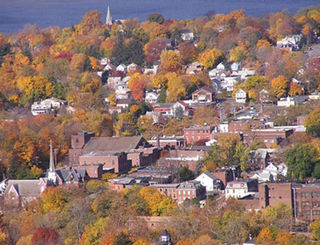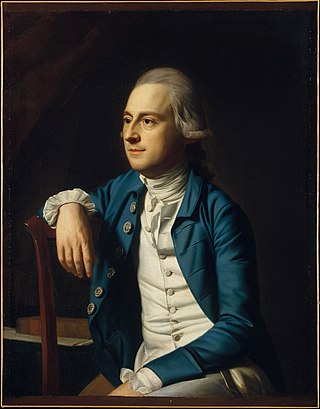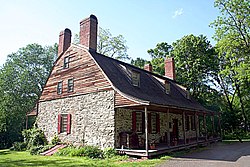
Dutchess County is a county in the U.S. state of New York. As of the 2020 census, the population was 295,911. The county seat is the city of Poughkeepsie. The county was created in 1683, one of New York's first twelve counties, and later organized in 1713. It is located in the Mid-Hudson Region of the Hudson Valley, north of New York City.

Beacon is a city located in Dutchess County, New York, United States. The 2020 census placed the city total population at 13,769. Beacon is part of the Poughkeepsie–Newburgh–Middletown, New York Metropolitan Statistical Area as well as the larger New York–Newark–Bridgeport, New York–New Jersey–Connecticut–Pennsylvania Combined Statistical Area.

Wappinger is a town in Dutchess County, New York, United States. The town is located in the Hudson River Valley region, on the eastern bank of the Hudson River. The population was 28,216 at the 2020 census. The name is derived from the Wappinger Native Americans who inhabited the area. Wappinger comprises three-fourths of the incorporated village of Wappingers Falls, several unincorporated hamlets such as Chelsea, Diddell, Hughsonville, Middlebush, Myers Corners, New Hackensack, and Swartwoutville, and a number of neighborhoods.

Fishkill is a village within the town of Fishkill in Dutchess County, New York, United States. The village is in the eastern part of the town of Fishkill on U.S. Route 9. It is north of Interstate 84. NY 52 is the main street. It is part of the Poughkeepsie–Newburgh–Middletown, NY Metropolitan Statistical Area as well as the larger New York–Newark–Bridgeport, NY-NJ-CT-PA Combined Statistical Area. The first U. S. Post Office in New York state was established in Fishkill by Samuel Loudon, its first Postmaster.

Fishkill is a town in the southwestern part of Dutchess County, New York, United States. It lies approximately 60 miles (97 km) north of New York City. The population was 22,107 at the 2010 census. Fishkill surrounds the city of Beacon, and contains a village, which is also named Fishkill.

Fishkill Creek is a tributary of the Hudson River in Dutchess County, New York, United States. At 33.5 miles (53.9 km) it is the second longest stream in the county, after Wappinger Creek. It rises in the town of Union Vale and flows generally southwest to a small estuary on the Hudson just south of Beacon. Part of its 193-square-mile (500 km2) watershed is in Putnam County to the south. Sprout Creek, the county's third-longest creek, is its most significant tributary. Whaley and Sylvan lakes and Beacon Reservoir, its largest, deepest and highest lakes, are among the bodies of water within the watershed.

The Madam Brett Homestead is an early 18th-century home located in the city of Beacon, New York, United States. It is the oldest standing building in this part of Dutchess County and has been listed in the National Register of Historic Places since 1976. It is also listed on the NYS Independence Trail.

The Van Wyck Homestead Museum or Van Wyck-Wharton House is an early 18th-century Dutch colonial house in the Town of Fishkill, New York, United States of America. It served as a headquarters to a major military supply depot during the American Revolutionary War and has been listed on the National Register of Historic Places since April 13, 1972; the adjoining Fishkill Supply Depot Site has been listed on the NRHP since January 21, 1974. It is located on US 9 just south of Interstate 84. Excavations during the construction of a nearby gas station and the Dutchess Mall in the early 1970s unearthed many artifacts at the site, particularly materiel.

Daniel Crommelin Verplanck was a United States representative from New York.

Gulian Crommelin Verplanck was an American attorney, politician, and writer. He was elected to the New York State Assembly and Senate, and later to the United States House of Representatives from New York, where he served as Chairman of the influential House Ways and Means Committee.

Stony Kill Farm is located on NY 9D in the Town of Fishkill, New York, United States. It is a 1,000+ acre (3 km2) working farm owned and operated by the state Department of Environmental Conservation (DEC) as an environmental education center.

Gulian Verplanck was an American banker and politician.
Francis Rombouts was the 12th Mayor of New York City,, from 1679 to 1680. He was one of three proprietors of the Rombout Patent, and father of pioneering Colonial businesswoman Catheryna Rombout Brett.

The Storm–Adriance–Brinckerhoff House is located on Beekman Road in East Fishkill, New York, United States. It is a wooden building in three parts, the oldest of which dates to the mid-18th century.
Wheeler Hill Historic District is a federally recognized historic district located at Wappinger in Dutchess County, New York. Along the eastern shore of the Hudson River, atop of the Van Wyck Ridge is the "estates region of the Town of Wappinger". A scenic location, with roads lined with stone walls, properties greeting guests with magnificent stone pillars and iron gates, it includes 49 contributing buildings, 15 contributing sites, and four contributing structures. It encompasses the estates of Obercreek, Elmhurst, Edge Hill, Henry Suydam, William Crosby, and Carnwath that were developed between 1740 and 1940. Also included are two 18th century riverfront commercial structures, the Lent / Waldron Store and Stone House at Farmer's Landing. It was added to the National Register of Historic Places in 1991. Today the historic district is mostly made up of residential houses, but Carnwath and Obercreek are opened to the public.
Abraham Isaacsen Verplanck (1606–1690), also known as Abraham Isaacse Ver Planck, was an early and prominent settler in New Netherlands. A land developer and speculator, he was the progenitor of an extensive Verplanck family in the United States. Immigrating circa 1633, he received a land grant at Paulus Hook in 1638.

The Rombout Patent was a Colonial era land patent issued by King James II of England in 1685 sanctioning the right of Francis Rombouts and his partners Stephanus Van Cortlandt and Jacobus Kip to own some 85,000 acres (34,000 ha) of land they had purchased from Native Americans. The Patent included most of what is today's southern Dutchess County, New York.

Catheryna Rombout Brett was the daughter of New York City mayor and land baron Francis Rombouts and Helena Teller Bogardus Van Ball. She inherited a one-third interest in the sprawling Rombout Patent in today's southern Dutchess County, New York, at just four years old. At 16 she married a formal British naval lieutenant, Roger Brett, and the two relocated afterwards from the family home in New York City to their land upstate, reportedly the first permanent White settlers there.
Gulian Verplanck (1637–1684) was a Dutch-American fur trader and merchant in colonial New York.
















